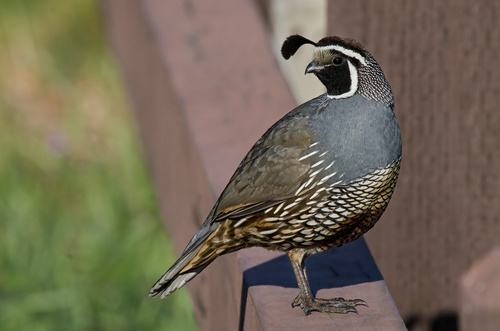
California Quail
The California Quail (*Callipepla californica*) is a small, plump ground-dwelling bird native to the western United States, particularly California. It's easily recognized by its distinct forward-nodding head plume, or topknot, which is made of six feathers. These birds are highly social, often seen in coveys, and play an important ecological role as seed dispersers and prey for larger animals. They have also become a symbol of California, designated as the state bird.
24-27 cm
Length
32-37 cm
Wingspan
Least Concern
Conservation Status
Distribution
Primarily found in California, Oregon, Nevada, Utah, and Baja California. Introduced populations exist in other western states, Hawaii, and parts of South America and New Zealand. It is a non-migratory bird.
Lifespan
Typically 1-2 years in the wild, up to 7 years in captivity.
California Quail's Habitat
Habitat Types
Chaparral, Oak woodlands, Grasslands, Coastal sage scrub, Agricultural areas (with sufficient cover)
Climate Zones
Mediterranean, Temperate, Arid
Adaptations
Strong legs and claws for scratching and running on the ground. Cryptic coloration provides camouflage in dense vegetation.
Variations
Several subspecies exist, differing slightly in plumage coloration and geographic distribution (e.g., *C. c. californica*, *C. c. plumbea*).
Appearance
Breeding Plumage
No significant seasonal change.
Seasonal Feather Changes
None
Sex Based Plumage Differences
Males have a black throat and face bordered by a white stripe, while females have a duller brown throat and face.
Notable Features
Distinct forward-curving head plume (topknot), Scaled pattern on belly feathers, Gray-blue breast and brown back
Diet and Feeding
Primary Foods
Seeds, Leaves, Flowers, Berries, Insects (especially during breeding season)
Foraging Behavior
Forages on the ground, scratching with feet to uncover seeds and insects. Often feeds in coveys, with some birds acting as sentinels.
Specializations
Strong gizzard for grinding seeds.
Seasonal Diet Variations
More insects consumed during breeding season to provide protein for chicks. Relies more on seeds in fall and winter.
Behavior
Social Structure
Forms coveys (family groups) of up to 75 or more birds, especially outside of breeding season. During the breeding season, they may form smaller groups or pairs.
Communication
Variety of calls, including the 'chi-ca-go' call, Soft clucking sounds for contact within coveys, Alarm calls to warn of predators
Migration
Non-migratory, but may make short-distance movements in response to food availability or weather.
Territorial or Group Behaviors
Males defend small territories during breeding season. Coveys maintain a home range.
Conservation
Threats
Habitat loss and fragmentation (due to urbanization and agriculture), Pesticide use, Predation by domestic cats and other introduced predators
Protection Programs
Habitat restoration projects, Hunting regulations
Local National Laws
Protected under the Migratory Bird Treaty Act in the United States, despite being non-migratory.
Population Trend
Generally stable, but some local declines have been observed.
Population Estimates
Estimated at several million birds globally.
Interesting Facts
California Quail are known for their rapid running speed.
They can run up to 12 mph (19 km/h) to escape predators.
The head plume is larger in males than in females.
It plays a role in courtship displays.
Chicks are precocial, meaning they are relatively mature and mobile from the moment of hatching.
This allows them to quickly follow their parents and forage for food.
Faqs about California Quail
What do California Quail eat?
They primarily eat seeds, leaves, flowers, berries, and insects.
Are California Quail migratory?
No, they are non-migratory.
What is a group of California Quail called?
A group of quail is called a covey.
Is the California Quail the state bird of California?
Yes.
Copyright @ Nature Style Limited. All Rights Reserved.
 English
English